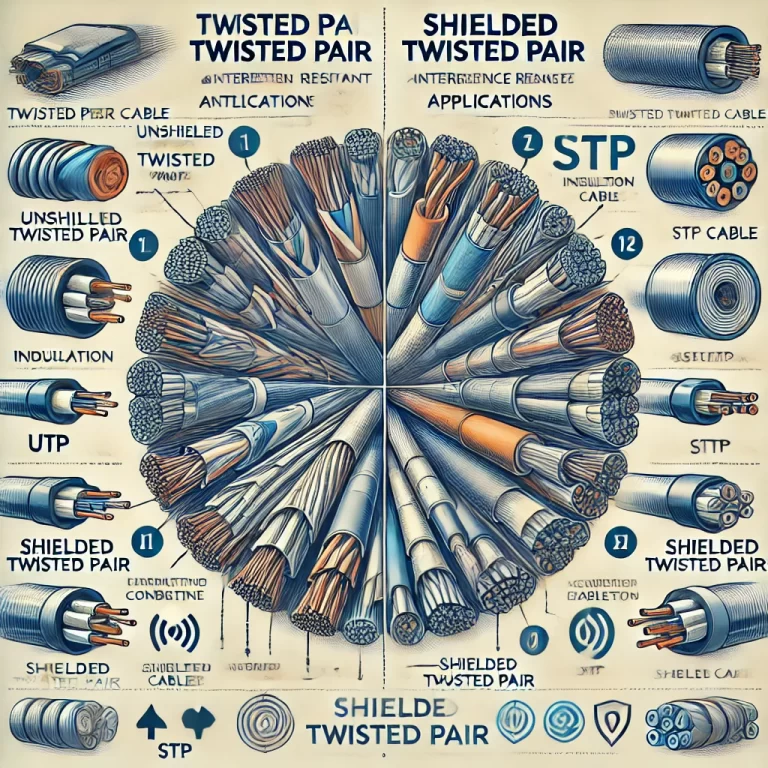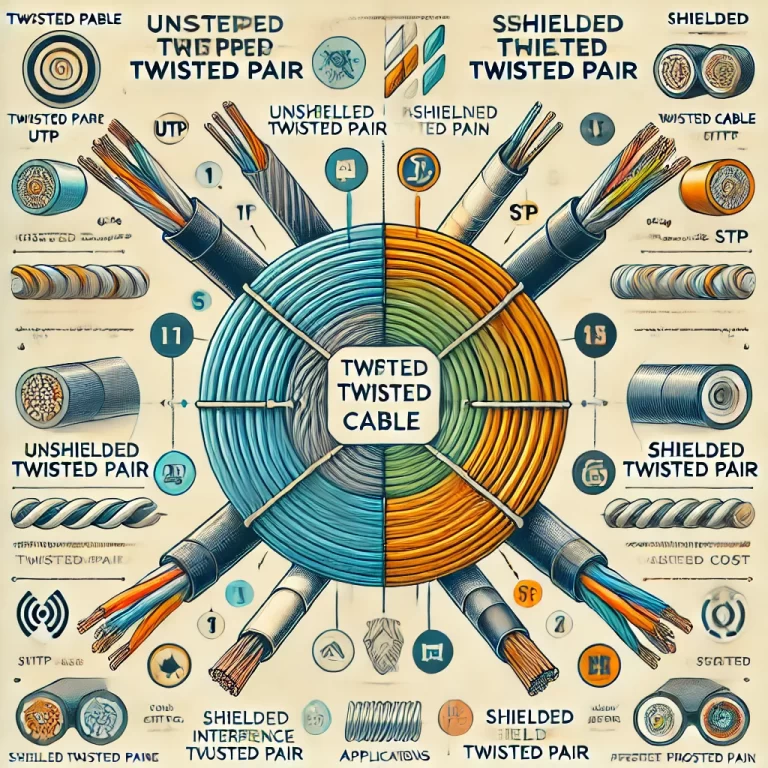In the realm of networking and data transmission, cables play a crucial role in ensuring the reliable flow of information. Two of the most common cable types are twisted pair cables and shielded cables. These cables are designed to transmit electrical signals but differ significantly in their construction, functionality, and application. Understanding these differences is essential for choosing the right cable for your specific needs.
1. Basic Structure
Twisted Pair Cable:
A twisted pair cable consists of pairs of copper wires that are twisted together. The twisting of the wires helps reduce the potential for electromagnetic interference (EMI) from external sources, as well as crosstalk between adjacent pairs of wires within the cable. There are two main types of twisted pair cables:
- Unshielded Twisted Pair (UTP): These cables do not have any additional shielding around the twisted pairs of wires. UTP cables are the most common type and are used in applications such as Ethernet networks (e.g., Cat5e, Cat6).
- Shielded Twisted Pair (STP): These cables include an additional layer of shielding (e.g., foil or braided metal) around the twisted pairs to provide extra protection against external interference.
Shielded Cable:
A shielded cable typically consists of a central conductor, an insulating layer, a shielding layer (often made of metal, such as aluminum or copper), and an outer protective jacket. The shield functions as a barrier to prevent external electromagnetic interference (EMI) from affecting the signal. Shielded cables are often used in applications where the environment is electrically noisy or when signals need to be transmitted over long distances without degradation.

2. Interference Resistance
One of the most significant differences between twisted pair cables and shielded cables is their ability to resist electromagnetic interference (EMI).
Twisted Pair Cable: The twisting of the wires in a twisted pair cable helps cancel out some of the electromagnetic interference. This is because the electrical signals in each wire are inversely related, and the twisting causes the interference to affect both wires equally, thereby minimizing the potential disruption to the transmitted signal. While this method works well for reducing low-level interference, it does not provide the same level of protection against high levels of EMI as a shielded cable.
- UTP (Unshielded Twisted Pair) cables are more susceptible to interference, especially in environments with high levels of electrical noise (e.g., industrial areas).
- STP (Shielded Twisted Pair) cables, on the other hand, incorporate a metal shielding that further reduces the susceptibility to interference, making them more suitable for environments with high EMI.
Shielded Cable: Shielded cables, with their metallic outer layer, offer superior protection against external electromagnetic interference. The shield acts as a Faraday cage, blocking unwanted signals from entering or exiting the cable, thereby preserving the integrity of the transmitted signal. This makes shielded cables ideal for use in electrically noisy environments or where signal quality is critical, such as in industrial control systems, audio/video systems, and high-speed data networks.
3. Applications
Both twisted pair cables and shielded cables have widespread applications, though the choice of cable depends on the specific requirements of the task at hand.
- Twisted Pair Cable: Twisted pair cables are commonly used in various data transmission and communication applications. They are particularly popular in local area networks (LANs) and telecommunication systems, as they are cost-effective and offer sufficient performance for most networking needs.
- UTP cables are widely used in Ethernet networks (e.g., Cat5e, Cat6, Cat7) due to their affordability and sufficient performance for typical home or office network setups.
- STP cables are employed in environments where some level of electromagnetic interference is expected, such as data centers or office buildings with high electrical activity.
- Shielded Cable: Shielded cables are typically used in environments with high interference, or where the integrity of the signal must be preserved over long distances. For example, audio and video cables often use shielding to maintain signal clarity in professional environments, such as in recording studios or broadcasting stations. Similarly, in industrial settings, where machinery and equipment create significant EMI, shielded cables are essential for ensuring the reliability of control systems and data transmission.
4. Cost Considerations
- Twisted Pair Cable: Twisted pair cables are generally less expensive to produce and install compared to shielded cables. The manufacturing process for twisted pair cables is simpler, and they require fewer materials, particularly if they are unshielded. Therefore, they are often the go-to choice for home networks, small businesses, and situations where cost is a significant concern.
- UTP cables are among the most affordable options, making them ideal for budget-conscious projects that do not face high levels of external interference.
- STP cables, being shielded, are more expensive than UTP cables, though they still remain relatively affordable compared to fully shielded cables.
- Shielded Cable: Shielded cables are more expensive due to the additional materials and construction complexity. The metal shielding adds to the cost, as does the need for more robust insulation and protective layers. However, for certain critical applications, the added cost is justified by the increased durability and performance in high-interference environments.
5. Signal Transmission Distance and Quality
Twisted Pair Cable: The performance of twisted pair cables diminishes over longer distances due to signal attenuation (loss of signal strength) and the potential for interference. In typical Ethernet networks, the maximum recommended length for UTP cables is around 100 meters (328 feet) at speeds of up to 1 Gbps. For longer distances or higher speeds, additional equipment like repeaters or switches is often required to maintain signal quality.
Shielded Cable: Shielded cables tend to perform better over longer distances, as the shield provides a stronger defense against external interference and signal degradation. This makes them ideal for high-speed data transmission and critical communication lines where consistent signal quality over distance is essential.

Conclusion
In summary, the choice between twisted pair cables and shielded cables largely depends on the specific requirements of the installation, including the environment, budget, and desired performance:
Twisted pair cables are generally sufficient for most home and office networking needs, offering good performance at a lower cost. For environments with low interference, UTP is often a viable choice, while STP offers extra protection for moderately noisy environments.
Shielded cables provide superior protection against electromagnetic interference, making them essential for high-performance or interference-prone environments such as industrial settings, professional audio systems, or long-distance data transmission.
By considering factors like signal integrity, interference protection, transmission distance, and cost, you can select the appropriate cable for your specific use case.
